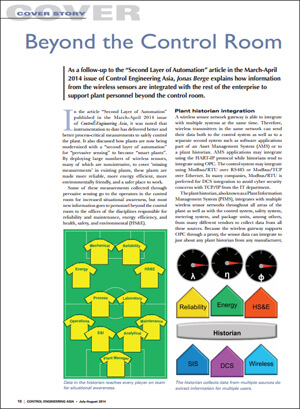For many plants and production facilities, instrumentation devices measuring the process were limited to just what was needed for monitoring and control due to installation costs and complexity. Wireless instrumentation has opened up the opportunity to add measurements to increase reliability, improve energy efficiency, reduce emissions and increase overall safety.

Jonas Berge
Director, Applied Technology
 Emerson’s Jonas Berge wrote a follow up article, Beyond the Control Room, to his earlier Control Engineering Asia article, Second Layer of Automation. I highlighted some excerpts from the Second Layer article in an earlier post, Business Critical Measurement Instrumentation-Second Layer of Automation.
Emerson’s Jonas Berge wrote a follow up article, Beyond the Control Room, to his earlier Control Engineering Asia article, Second Layer of Automation. I highlighted some excerpts from the Second Layer article in an earlier post, Business Critical Measurement Instrumentation-Second Layer of Automation.
In this Beyond the Control Room article, Jonas builds on how these extra measurements provide pervasive sensing to various groups across the plant:
Some of these measurements collected through pervasive sensing go to the operators in the control room for increased situational awareness, but most new information goes to personnel beyond the control room to the offices of the disciplines responsible for reliability and maintenance, energy efficiency, and health, safety, and environmental (HS&E).
The wireless sensor network can connect with several systems and software platforms:
…both to the control system as well as to a separate second system such as software applications part of an Asset Management System (AMS) or to a plant historian.
Jonas offers some examples of ways this data can be used:
Specialized third-party applications such as energy management software can access data from all the underlying data sources such as the control system and wireless sensor networks through the plant historian in real-time or as historical data. This integration capability is ideal for energy management.
…
The plant information historian brings data beyond the control room as the historian server is accessible from client computers on the corporate network enabling disciplines responsible for maintenance, reliability, energy management, and HS&E to access the data they need right from the desk in their office.
From a reliability and maintenance perspective:
Plants are now modernized with wireless transmitters for vibration, temperature, and pressure mounted on process equipment measuring these leading indicators of failure, feeding their raw data into the plant historian. These measurements have been missing until today. The real-time analytics component of the historian is used to compute equipment condition from the raw data from the sensors on the equipment and process variables from the control system using specific software algorithms created for each type of process equipment such as pumps, heat exchangers, and compressors etc.
From an energy management perspective:
Wireless transmitters for metering of energy consumption of all types like steam, compressed air, fuels, and water are now deployed throughout the plant feeding their raw data into the plant historian. Electricity consumption is also measured. A realtime energy management system analytics component integrated with the historian is used to take the raw metering data from the control system and wireless sensor network to roll-up the unit-wise consumption into energy account centers. The information goes into daily, weekly, and monthly energy reports on the energy manager’s desktop.
For HS&E:
Pervasive sensing in combination with a plant historian helps the HS&E officer meet regulatory emission reporting requirements and provides the ability to easily verify that bypass valves and other valves are not left in the wrong position. It also automates the documentation of periodic function check of safety showers and eye wash stations.
Jonas closes describing the role of pervasive sensing in integrated operations (iOps):
The Integrated Operations concept is primarily used on oil and gas production, but parts of this concept also apply to downstream and other process industries. A remote link between corporate operations and engineer centre and sites around the world enable Subject Matter Experts (SME) to remotely view any asset to assist in diagnostics and troubleshooting etc. That is, an SME in a central location can support many plants which do not have an SME at site. This is enabled by secure broadband Internet connection for plant data and for video conferencing.
Read the article for more on how these additional measurements impact business-level activities across the plant or production facility. You can connect and interact with other operations experts in the Operate & Maintain and Improve & Modernize groups in the Emerson Exchange 365 community.




